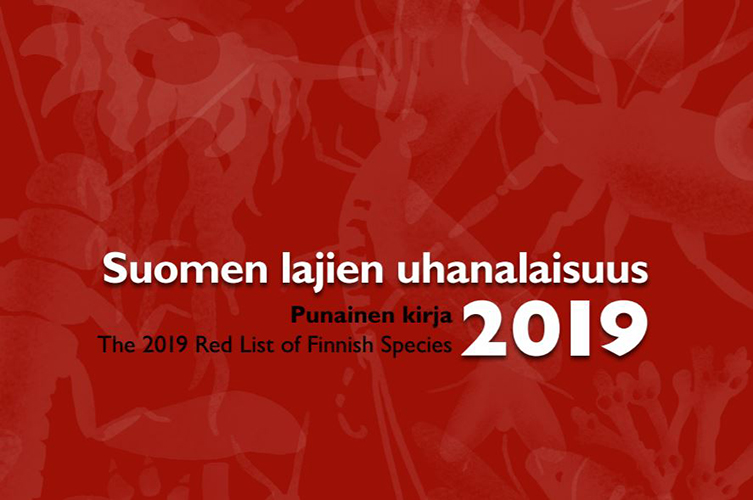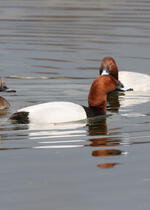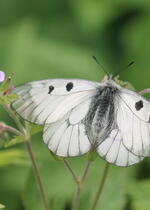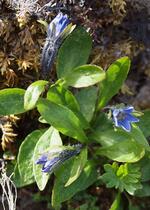Red List of Finnish species - every ninth species in Finland is threatened
A new assessment of threatened species indicates an increasing loss of biodiversity in Finnish nature. Of the 22,000 species evaluated, 11.9% were classified as threatened. The highest proportion of threatened species is found among birds and bryophytes (mosses). The primary threat is the decline and deterioration of natural habitat – urgent action is needed to stop this decline.

Photo: Ministry of the Environment and the Finnish Environment Institute (SYKE)
Largest proportion of threatened species among birds and bryophytes
Approximately one third of Finnish bird and bryophyte species are under threat. The proportion of threatened species is also large among lichens, vascular plants, butterflies and moths, and hymenopterans. The situation has deteriorated in all of these groups since the previous evaluation in 2010. Almost one third of vertebrate animals are threatened. Twenty-three species are Critically Endangered (CR) including, the Arctic fox (Vulpes lagopus), landlocked salmon (Salmon salar m. sebago) and ortolan bunting (Emberiza hortulana).
 The common pochard (Aythya ferina), which inhabits eutrophic lakes and marshes, has been classified as critically endangered (CR) due to a massive decrease in its population. The decline in population is most likely due to competition with fish for food resources, predation by small carnivores and the disappearance of the black-headed gull (Larus ridibundus) from many bird waters, as the common pochard nests most successfully in black-headed gull colonies. The species is also threatened by hunting.
Photo: Juha Laaksonen
The common pochard (Aythya ferina), which inhabits eutrophic lakes and marshes, has been classified as critically endangered (CR) due to a massive decrease in its population. The decline in population is most likely due to competition with fish for food resources, predation by small carnivores and the disappearance of the black-headed gull (Larus ridibundus) from many bird waters, as the common pochard nests most successfully in black-headed gull colonies. The species is also threatened by hunting.
Photo: Juha Laaksonen
The common pochard (Aythya ferina), which inhabits eutrophic lakes and marshes, has been classified as Critically Endangered (CR) due to a massive population decrease of over 90% in 23 years. The decline in population is most likely due to competition with fish for food resources, predation by small carnivores and the disappearance of the black-headed gull (Larus ridibundus) from many bird waters; the common pochard nests most successfully in black-headed gull colonies. The common pochard is also threatened by hunting.
Approximately 10% of Finnish insect species are threatened. For example, for 152 butterfly and moth species, the situation has improved, as many of the southern species have benefited from climate warming. Conversely, over 200 butterfly and moth species have become more threatened than previously, mainly due to forestry and habitat overgrowth.
 Pikkuapollo, Parnassius mnemosyne is a Vulnerable (VU) butterfly living in herb-rich grasslands and wooded pastures. The species has three natural areas of occupancy. Through successful reintroduction, the species has additionally been restored to a fourth area, where it was observed last in the early 20th century. The species is dependent on grazing and is threatened by the overgrowing of open areas.
Photo: Mikko Kuussaari
Pikkuapollo, Parnassius mnemosyne is a Vulnerable (VU) butterfly living in herb-rich grasslands and wooded pastures. The species has three natural areas of occupancy. Through successful reintroduction, the species has additionally been restored to a fourth area, where it was observed last in the early 20th century. The species is dependent on grazing and is threatened by the overgrowing of open areas.
Photo: Mikko Kuussaari
Parnassius mnemosyne is a Vulnerable (VU) butterfly living in herb-rich grasslands and wooded pastures. The species has three natural areas of occupancy. Through successful reintroduction, the species has additionally been restored to a fourth area, where it was last observed in the early 20th century. The species is dependent on grazing and is threatened by the overgrowing of open areas. Photo: Mikko Kuussaari
Species becoming more threatened in all habitats
Species are becoming threatened the fastest in fell areas, mires, aquatic habitats and rock outcrops. The species most at threat in fell areas include butterflies, moths and vascular plants; climate change is a major threat, affecting 16 of these species in the fell areas.
The majority of threatened species live in forests and rural biotopes, as well as other environments established as a result of human activity. As a whole, species in these habitats are declining at a slower pace than in fell areas and mires. The forests and rural biotopes are home to the most species, which partly explains the large number of threatened species.

Kiirunankello, Campanula uniflora grows on shady calcareous rock outcrops of fells. The plant species is very rare and scarce here, and it is classified as Critically Endangered (CR). The species is particularly sensitive to the effects of global warming.
Photo: Kimmo SyrjänenCampanula uniflora grows on shady calcareous rock outcrops of fells. The plant species is very rare and scarce here, and it is classified as Critically Endangered (CR). The species is particularly sensitive to the effects of global warming. Photo: Kimmo Syrjänen
The biggest threat is the decline and degradation of habitat
Changes in the forest environment are the most significant threats to 733 forest dwelling species. These changes include forest management activities, the reduction of old-growth forests and large trees, and decreasing amounts of dead and decaying wood.
The second most common threat to species overall is the overgrowing of open habitats; this is the primary threat to 639 species. In fell areas, climate change poses a particular threat to over 80% of species.
Concrete actions to improve the situation for species
Much can be done to stop the decline of species. In the Red List of Finnish Species, both broad and targeted measures are presented to improve the living conditions of species. Conservation areas alone cannot ensure the protection of species. Instead, biodiversity must be taken into account in all use of natural resources and areas.
Active conservation, restoration and management measures – such as habitat and hunting protection and the winter-feeding of the White-tailed Sea Eagle – are already in effect, but these types of measures should be significantly increased, particularly to protect species in mires and bird wetlands. More information about species occurrence and interactions is required to improve conservation action.
The fifth assessment of threatened species in Finland
The assessment of threatened species in Finland was carried out for the fifth time. The work was coordinated by the Finnish Environment Institute (SYKE), and it involved 180 experts from universities, museums of natural history, Natural Resources Institute Finland, Finnish Environment Institute (SYKE), Metsähallitus and the Finnish Mammalogical Society. In addition, expert enthusiasts and retired natural scientists gave their valuable contribution to the assessment. A steering group appointed by the Ministry of the Environment guided the work and approved the assessments.

